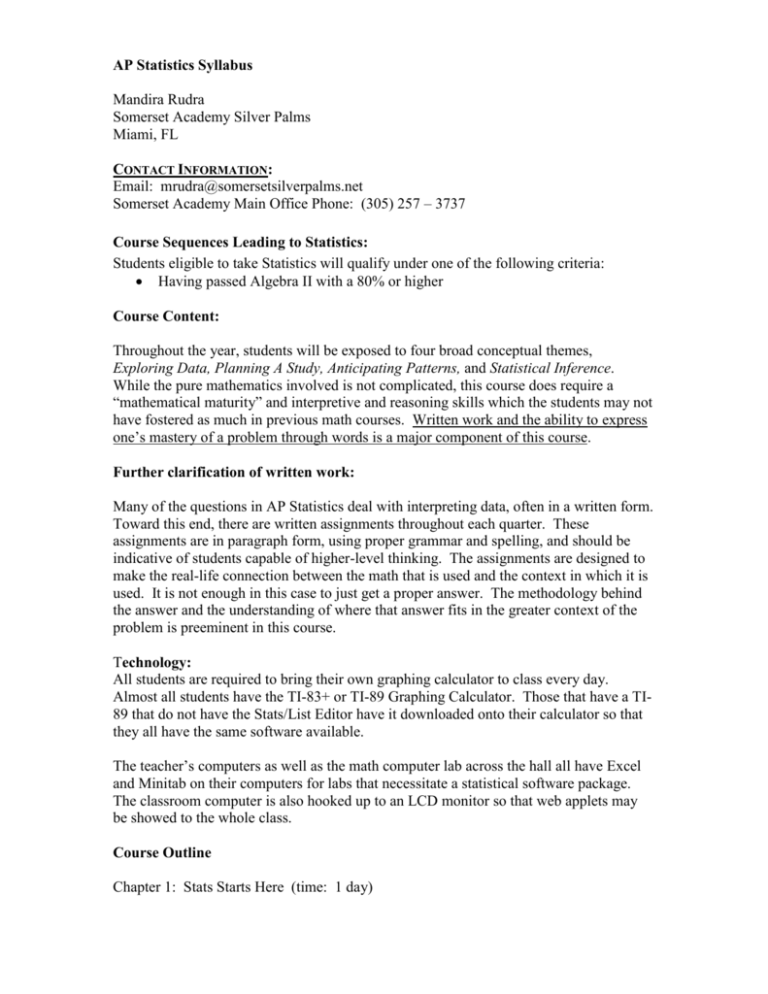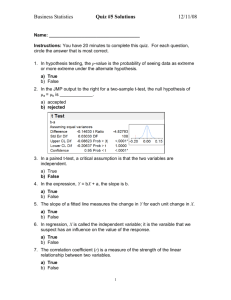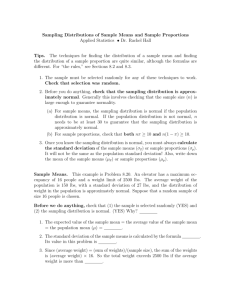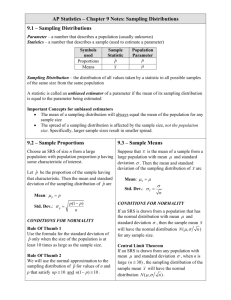AP Statistics Student Syllabus - Somerset Academy Silver Palms
advertisement

AP Statistics Syllabus Mandira Rudra Somerset Academy Silver Palms Miami, FL CONTACT INFORMATION: Email: mrudra@somersetsilverpalms.net Somerset Academy Main Office Phone: (305) 257 – 3737 Course Sequences Leading to Statistics: Students eligible to take Statistics will qualify under one of the following criteria: Having passed Algebra II with a 80% or higher Course Content: Throughout the year, students will be exposed to four broad conceptual themes, Exploring Data, Planning A Study, Anticipating Patterns, and Statistical Inference. While the pure mathematics involved is not complicated, this course does require a “mathematical maturity” and interpretive and reasoning skills which the students may not have fostered as much in previous math courses. Written work and the ability to express one’s mastery of a problem through words is a major component of this course. Further clarification of written work: Many of the questions in AP Statistics deal with interpreting data, often in a written form. Toward this end, there are written assignments throughout each quarter. These assignments are in paragraph form, using proper grammar and spelling, and should be indicative of students capable of higher-level thinking. The assignments are designed to make the real-life connection between the math that is used and the context in which it is used. It is not enough in this case to just get a proper answer. The methodology behind the answer and the understanding of where that answer fits in the greater context of the problem is preeminent in this course. Technology: All students are required to bring their own graphing calculator to class every day. Almost all students have the TI-83+ or TI-89 Graphing Calculator. Those that have a TI89 that do not have the Stats/List Editor have it downloaded onto their calculator so that they all have the same software available. The teacher’s computers as well as the math computer lab across the hall all have Excel and Minitab on their computers for labs that necessitate a statistical software package. The classroom computer is also hooked up to an LCD monitor so that web applets may be showed to the whole class. Course Outline Chapter 1: Stats Starts Here (time: 1 day) Activity: Opening Day Survey Unit 1: Exploring and Understanding Data (time: 5 weeks) Categorical vs Quantitative data Displaying and Describing Categorical Data o Relative frequency table o Bar charts o Pie charts o Contingency tables – marginal & conditional distributions o Independence o Segmented bar chart o Simpson’s Paradox Displaying Quantitative Data o Histograms o Stem-and-Leaf Display o Dotplot o Center, Shape and Spread o Modes – unimodal, bimodal, uniform o Symmetry, skewness o Outliers o Timeplot o Cumulative frequency graphs Activity: Matching Graphs to Variables Describing Distributions Numerically o Center - Mean, median, midrange o Spread – range, interquartile range, percentiles o 5-number summary o Boxplots o Variance & Standard deviation Activity: Matching Statistics to Graphs Standard Deviation and the Normal Model o Standardized values – z-scores o Standard Normal distribution o Empirical rule (68-95-99.7 rule) o Normal probability plot Unit 2: Exploring Relationships Between Variables (time: 4 weeks) Scatterplots, Association and Correlation o Scatterplot o Association - Direction and strength o Explanatory and response variable o Correlation – strength of a linear relationship o R – correlation coefficient o Correlation vs Causation Activity: Matching Correlations to Scatterplots (web applet) Linear Regression o Linear model o Residual o Least squares regression line o Coefficient of determination – r2 o Residual plot – what to look for o Extrapolation o Outliers – influential points o Lurking variables Re-expressing Data Unit 3: Gathering Data (time: 3 weeks) Understanding randomness o Simulation o Table of random digits Activity: Yahtzee Sample Surveys o Population, sample o Bias, randomization o Sample size, census o Population parameter vs sample statistic o Simple random sample (SRS) o Sampling frame, sampling variability o Stratified random sample, cluster, multistage, systematic o Convenience, voluntary response sample o Undercoverage, nonresponse, response bias, wording of questions Experiments o Observational study o Response, subjects, experimental units, treatments, factors, levels o Principles of Experimental Design: Control, Randomness, Replication o Blocking o Statistically Significant o Control group, single- and double-blind, placebo o Matched Pairs o Lurking variables, confounding variables Unit 4: Randomness and Probability (time: 4 weeks) From Randomness to Probability o Probability, trial, outcome, event o Independence, mutually exclusive (disjoint) o Law of Large Numbers o Addition Rule and Multiplication Rule Probability Rules o Sample space o Conditional probability o Tree diagrams Random Variables o Random variables: discrete and continuous o Probability model o Expected value (mean) and standard deviation o Sum and difference rules for mean and variance Activity: Playing the lottery Probability Models o Bernoulli trials o Geometric probability model o Binomial model o Binomial setting o Normal model o 10% condition, success/failure condition Unit 5: From the Data at Hand to the World At Large (Statistical Inference Pt 1) (time: 5 weeks) Sampling Distribution Models o Sampling Distribution Model for a Proportion o Approximation to Normal Models o Assumptions and Conditions o Sampling Distribution Model for Means o Central Limit Theorem o Importance of Random Sampling and Independence o Affect of Sample Size on Standard Deviation o Standard Deviation vs Standard Error Activity: Cents and the Central Limit Theorem Activity: Random Rectangles Confidence Intervals for Proportions o Margin of Error: Certainty vs Precision o Critical Values o Assumptions and Conditions o One-proportion z-interval o Interpretation of Interval in context o Interpretation of Confidence level in context Activity: Estimating Proportions: How Accurate Are the Polls? Testing Hypothesis about Proportions o Null and Alternative Hypothesis o Retain and Rejecting the Null o The Logic/Reasoning of a Hypothesis Test o Calculating the Test statistic and P-value o One-proportion z-test o Conclusion – always in context o One-sided vs two-sided alternative o How to interpret a P-value o Using a confidence interval as a follow-up to a Hypothesis Test o P-Value vs Alpha Level – when is it statistically significant? o Type I and Type II errors o Power of a test o How to reduce Type I and Type II errors – effect of sample size Comparing Two Proportions o Variance of the sum or difference of two independent random variables o Standard Deviation of the Difference Between two proportions o Assumptions and Conditions o Sampling Distribution Model for difference between two proportions o Two-Proportion z-interval o Pooling the data o Two-Proportion z-test Unit 6: Learning About the World (Statistical Inference Pt 2) (time: 4 weeks) Inferences About Means o When can’t you use a z-distribution? o T-distributions o Degrees of freedom o Sampling Distributions for means o Assumptions and Conditions – Nearly Normal o One-sample t-interval o One-sample t-test for the mean o Significance vs importance o Sample Size – how large is enough? Comparing Means o Comparing data through side-by-side graphs o Comparing two means o Z or t? o Two-sample t-interval for means o Two-sample t-test for means o Sampling Distribution for the difference between two means o Calculating the degrees of freedom o Pooled t-test Paired Samples and Blocks o When can data be paired? o Matched Pairs t-test o Paired Data Assumption o Matched Pairs t-interval o Blocking Unit 7: Inference When Variables are Related (time: 2 weeks) Chi-Square Distributions o Goodness-of-fit test o Assumptions and Conditions – counted data, expected cell o Calculating a Chi-Square statistic o Chi-Square test for Homogeneity o Chi-Square test for Independence o Contingency tables o Examining the residuals Inferences for Regression o Variability in the regression line o o o o o Assumptions and Conditions Standard Error for the slope Sampling Distribution for regression slopes Regression Slope t-test Confidence Interval for slope Review for AP Exam: (time: 3 weeks) Post AP-Exam: End of the year Project: (time: 2 weeks) ATTENDANCE POLICY: Attendance at each class period is expected, but will not be graded. In the event of an excused absence (such as an athletic or other activity approved by administration), you must contact me in advance to make the appropriate arrangements. In the case of an emergency or illness, you need to contact me. In the event of an absence, you are responsible for the material discussed during the missed class. You should check the web page and/or talk to a classmate to find out what you missed. In the case of an UNEXCUSED absence, the school policy will be followed. HOME LEARNING AND CLASS WORK ASSIGNMENTS: When completing assignments MUST show all of the steps used to solve the problem. Generally, simply writing the answer or solution is not acceptable. I use the “No Work, No Credit” policy. METHODS OF ASSESSMENT: -Quizzes, Formative assessments, and/or Exams will be given every one (1), two (2) or three (3) weeks or at the teacher’s discretion. -Quizzes 15% -Exams/Projects 35% -Formative assessments 25% -Class work/Home Learning 15% -Technology 10% GRADING SCALE: 90%-100% 80%-89% 70%-79% 60%-69% 0%-59% A B C D F MATERIALS NEEDED: -The school provides textbook to be used daily. Students may or may not take the book home. Please help maintain the school’s materials. -Other Materials: Composition book for Math journal Spiral notebook or a binder for classwork and notes Graphing Calculator Pencils Erasers Pens Highlighters Lined Paper Graph paper -WISH LIST (does NOT count for volunteer hours) – In order to help maintain a healthy and vibrant learning environment it would be greatly appreciated if the following can be provided. Copy Paper Expo Dry Erase Markers Anti-Bacterial (liquid) RULES: 1. Respect others (even if they disrespect you). 2. Be in your seat when the bell rings. 3. Come prepared to class. Bring all your materials to class every day. 4. Turn in completed assignments on time. 5. Follow the Somerset Academy Charter High Code of Conduct. 6. NO Cell phones, CD players, iPods, MP3 Players, etc are allowed in class. CONSEQUENCES: 1. Verbal Warning 2. Detention 3. Phone call home 4. Office Referral CLASS PROCEDURES: 1. As soon as you enter the classroom begin working on the Warm-Up Exercise. 2. You will have home learning every day. 3. All assignments should be dated and have your name written clearly in the upper right corner with your period. Every assignment should also have a clear title (e.g. page number and question numbers, if from a book). 4. Tardiness is not acceptable. If you enter class late, I will not go back and re-teach the lesson, you will also be responsible for missed material. Being tardy 3 times will result in detention. 5. At the end of class your area should be clean. You will be dismissed by Ms. Rudra, NOT THE BELL! 6. All material covered will be kept updated on the website by me regularly. If you are absent or miss class for any reason, you are responsible for learning the material & making up missed work by looking at the website. If you miss a home learning you will receive a Z. Make up will only be given for EXCUSED absences. 7. Detentions will be served after school, with a one day grace period. It is the student’s responsibility to arrange transportation home after the detention and to inform coaches or other after school advisors of the issue and of the absence from the activity. 8. Failure to serve detention will result in a phone call home and/or office referral. 9. If a cellular phone, CD player, iPod, MP3 Player, Game Boy, etc is heard or seen in class, it will be CONFISCATED. ACADEMIC DISHONESTY: Students are expected to be honest and ethical in their academic work. Academic dishonesty is defined as an intentional act of deception in one of the following areas: Cheating – Use or attempted use of unauthorized materials, information or study aids. Assisting – helping another commit an act of academic dishonesty Tampering –altering of interfering with evaluation instruments and documents Plagiarism- representing the words or ideas of another person as one‘s own. Academic dishonesty of any kind, WILL NOT BETOLERATED! If caught, the students will automatically receive a failing grade for the given assignment, quiz, or test. Please return this portion of the page by Friday, August 22, 2014. I have read and understand the expectations, classroom rules and classroom procedures for Ms. Rudra’s class and I will abide by them. _____ Student’s Name Parent/Guardian’s Name Student’s Signature ________________________________ Parent’s Email Address Parent/Guardian’s Signature ___________________________ Parent’s Phone Number






